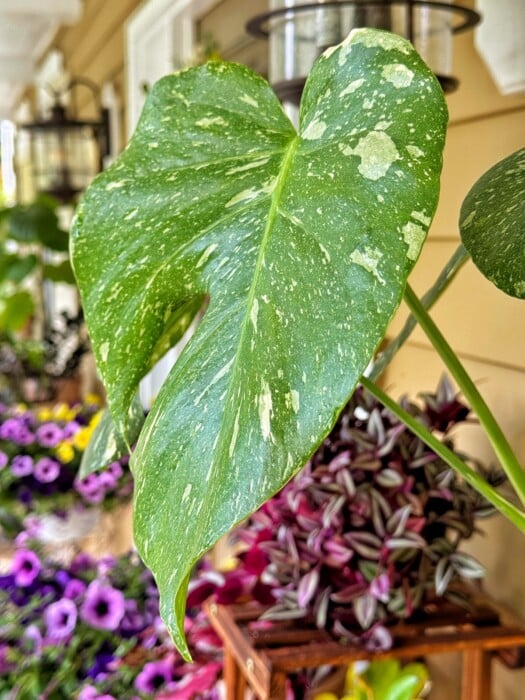Learn how to care for your split leaf philodendron with this easy-to-follow guide. Get tips on watering, light, and more!
The split leaf philodendron, with its dramatic, deeply lobed leaves, brings a touch of the tropics to any indoor space. This striking plant, often mistaken for its close relative the Monstera deliciosa (Swiss cheese plant), is a popular choice for plant enthusiasts of all levels, thanks to its relatively easy care and bold aesthetic.
I’ve been growing this plant for over fifteen years and have easily propagated it several times that I now have about six plants throughout my home! Let’s chat more about how fun the split leaf philodendron is to grow!
(Posts on stacyling.com may contain affiliate links. Click HERE for full disclosure.)

Getting to Know the Split Leaf Philodendron
While commonly called the split leaf philodendron, this captivating plant’s botanical name is Thaumatophyllum bipinnatifidum, though you might still find it sold under its former name, Philodendron bipinnatifidum.
Native to the tropical rainforests of South America, this plant thrives in warm, humid environments. In its natural habitat, it can reach a towering 50 feet, but don’t worry, indoors it typically reaches a more manageable 15 feet, still making a grand statement with its sculptural form. That said, I’ve been growing mine for close to 15 years now, and it can grow HUGE!
Beyond its impressive size, the split leaf philodendron boasts large, glossy leaves that can grow up to 3 feet long. These deeply divided leaves, resembling lush green feathers, create a sense of vibrant, tropical abundance. And while it rarely flowers indoors, the occasional bloom adds another layer of intrigue with its unique inflorescence, featuring a white spathe and spadix, characteristic of the aroid family.

Light
The split leaf philodendron thrives in bright, indirect light. Think of the dappled sunlight filtering through the rainforest canopy. You can achieve this indoors by placing your plant near a window with sheer curtains or in a well-lit room but away from direct sunlight. Since I’m growing a few of these now, I grow mine in north, west and east facing windows.
Direct sun can scorch the leaves, causing unsightly brown spots. On the other hand, insufficient light will result in slower growth, smaller leaves, and a loss of the deep green color. If you notice your plant becoming leggy or the leaves appearing pale, it’s a sign it needs more light. Conversely, if the leaves start to yellow or develop brown edges, it’s getting too much direct sun.
If you don’t have enough light in your home or access to windows, consider adding a grow light like this one so your plant can thrive.

Soil: The Foundation for Healthy Growth
Well-draining soil is crucial for the split leaf philodendron. These plants are susceptible to root rot if their roots sit in soggy soil. A good potting mix should allow excess water to drain freely while retaining enough moisture to keep the roots hydrated.
A recommended mix consists of peat moss, perlite, and orchid bark. Peat moss provides moisture retention, perlite improves drainage, and orchid bark adds aeration and structure. This combination creates a loose, airy environment that encourages healthy root development. Aim for a slightly acidic to neutral pH (6.0 – 7.0) for optimal growth.
While I usually repot my houseplants in a good, well draining chunky soil mix like I mentioned, I have found this plant to not be very picky about its accommodations. This pre-made chunky soil mix is a great option if you don’t want to make one yourself.
Temperature and Humidity: Recreating the Tropics
As a tropical plant, the split leaf philodendron enjoys warm temperatures and moderate to high humidity. Ideally, keep the temperature between 65-85°F (18-29°C). Avoid exposing your plant to temperatures below 55°F (13°C), as it is sensitive to cold drafts and sudden temperature fluctuations. Keep it away from cold windows and air conditioning vents.
To increase humidity around your plant, you can mist it regularly with water, use a pebble tray filled with water, or run a humidifier like this one. Grouping plants together can also create a microclimate with higher humidity.

Watering: Finding the Balance
Proper watering is essential for the health of your split leaf philodendron. Overwatering is a common problem and can lead to root rot, one of the most frequent causes of decline in these plants. Allow the top inch of soil to dry out completely before watering again. Stick your finger into the soil to check the moisture level or use a moisture meter like this one.
The frequency of watering will depend on several factors, including the size of the pot, the type of potting mix, the temperature, and the humidity levels. During the growing season (spring and summer), you’ll likely need to water more frequently than in the fall and winter when growth slows down.
Keep an eye out for signs of overwatering, such as yellowing leaves, wilting, and a foul odor from the soil. If you suspect overwatering, allow the soil to dry out completely before watering again. On the other hand, underwatering can cause the leaves to droop and the soil to become dry and compacted.
Fertilizing: A Little Goes a Long Way
The split leaf philodendron is not a heavy feeder. Fertilize once or twice a month during the growing season (spring and summer) with a balanced liquid fertilizer diluted to half strength. Avoid over-fertilizing, as this can lead to salt buildup in the soil and damage the roots. During the fall and winter, when growth slows down, you can reduce or stop fertilizing altogether.
I’ve been using an organic liquid fertilizer like this one every time I water, and my split leaf philodendrons LOVE it. They push out a ton of new growth and are really thriving – even in the winter.

Pests and Diseases: Keeping Your Split Leaf Philodendron Healthy
While generally resilient, split leaf philodendrons can occasionally be affected by common houseplant pests such as spider mites, mealybugs, and scale insects. Regularly inspect your plant for signs of pests, such as webbing, sticky residue, or small insects on the leaves.
If you notice any pests, you can treat them with insecticidal soap or neem oil. For more severe infestations, you may need to use a systemic insecticide.
Overwatering can lead to root rot, which can be fatal if left untreated. Ensure proper drainage and avoid letting the plant sit in water. Leaf spot diseases can also occur, often caused by fungal pathogens. These can be treated with fungicides.
The best way to prevent pest and disease problems is to maintain good cultural practices, including proper watering, lighting, and humidity. A healthy plant is much more resistant to pests and diseases.
Split Leaf Philodendron Propagation: Sharing the Love
Split leaf philodendrons can be propagated through several methods, making it easy to share this beautiful plant with friends and family or expand your own collection.
- Stem Cuttings: Take cuttings with at least one node and a few leaves. You can root these cuttings in water or directly in moist sphagnum moss. Once roots have developed, plant the cuttings in potting mix.
- Air Layering: This method involves making a cut on a stem and wrapping it with moist sphagnum moss. Cover the moss with plastic wrap to retain moisture. Once roots develop from the wounded area, you can cut the stem below the roots and pot the new plant.
- Division: This technique is best for mature plants with multiple stems. Carefully remove the plant from its pot and gently separate the root ball into sections, ensuring each section has both roots and stems. Pot each division in fresh potting mix.

Final Thoughts About Growing Split Leaf Philodendron
With its bold foliage and relatively easy care requirements, the split leaf philodendron is a rewarding plant to grow indoors. By providing the right light, water, humidity, and soil conditions, you can enjoy the lush, tropical beauty of this plant for years to come.
Remember to keep an eye out for signs of pests or diseases and take action promptly if needed. And don’t forget to propagate your plant to share its beauty with others.
For more information about growing the tree philodendron, read this article from North Carolina State Cooperative Extension.
To drill down on houseplant care basics and growing an indoor garden that thrives, please read my articles:
- Easy Houseplants for Busy People: The Low-Maintenance Approach to Growing an Indoor Garden
- From Shop to Home: How to Acclimate Your Tropical Plants
- Stop Guessing and Master Watering Indoor Plants Like a Pro
- How to Revive Houseplants You Thought Were Goners
- Is Your Houseplant Getting Enough Light? Here’s How to Tell.
Thank you for visiting the blog today!
Enjoy your day! xo







